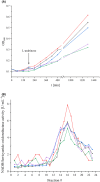Quinone chemistry in respiratory complex I involves protonation of a conserved aspartic acid residue
- PMID: 39262040
- PMCID: PMC11627005
- DOI: 10.1002/1873-3468.15013
Quinone chemistry in respiratory complex I involves protonation of a conserved aspartic acid residue
Abstract
Respiratory complex I is a central metabolic enzyme coupling NADH oxidation and quinone reduction with proton translocation. Despite the knowledge of the structure of the complex, the coupling of both processes is not entirely understood. Here, we use a combination of site-directed mutagenesis, biochemical assays, and redox-induced FTIR spectroscopy to demonstrate that the quinone chemistry includes the protonation and deprotonation of a specific, conserved aspartic acid residue in the quinone binding site (D325 on subunit NuoCD in Escherichia coli). Our experimental data support a proposal derived from theoretical considerations that deprotonation of this residue is involved in triggering proton translocation in respiratory complex I.
Keywords: Escherichia coli; NADH dehydrogenase; NADH:quinone oxidoreductase; iron–sulfur cluster; proton‐coupled electron transfer; quinone reduction; redox‐induced FTIR spectroscopy; site‐directed mutagenesis.
© 2024 The Author(s). FEBS Letters published by John Wiley & Sons Ltd on behalf of Federation of European Biochemical Societies.
Figures



Similar articles
-
Asp563 of the horizontal helix of subunit NuoL is involved in proton translocation by the respiratory complex I.FEBS Lett. 2012 Mar 23;586(6):699-704. doi: 10.1016/j.febslet.2012.01.056. Epub 2012 Feb 3. FEBS Lett. 2012. PMID: 22326235
-
Spin labeling of the Escherichia coli NADH ubiquinone oxidoreductase (complex I).Biochim Biophys Acta. 2010 Dec;1797(12):1894-900. doi: 10.1016/j.bbabio.2010.10.013. Epub 2010 Oct 16. Biochim Biophys Acta. 2010. PMID: 20959113
-
Essential regions in the membrane domain of bacterial complex I (NDH-1): the machinery for proton translocation.J Bioenerg Biomembr. 2014 Aug;46(4):279-87. doi: 10.1007/s10863-014-9558-8. Epub 2014 Jun 29. J Bioenerg Biomembr. 2014. PMID: 24973951 Review.
-
Redox-induced conformational changes within the Escherichia coli NADH ubiquinone oxidoreductase (complex I): an analysis by mutagenesis and FT-IR spectroscopy.Biochim Biophys Acta. 2010 Jun-Jul;1797(6-7):659-63. doi: 10.1016/j.bbabio.2010.03.002. Epub 2010 Mar 7. Biochim Biophys Acta. 2010. PMID: 20214873
-
A possible role for iron-sulfur cluster N2 in proton translocation by the NADH: ubiquinone oxidoreductase (complex I).J Mol Microbiol Biotechnol. 2005;10(2-4):208-22. doi: 10.1159/000091566. J Mol Microbiol Biotechnol. 2005. PMID: 16645316 Review.
Cited by
-
ATP requirements for growth reveal the bioenergetic impact of mitochondrial symbiosis.Biochim Biophys Acta Bioenerg. 2025 Jun 23;1866(4):149564. doi: 10.1016/j.bbabio.2025.149564. Online ahead of print. Biochim Biophys Acta Bioenerg. 2025. PMID: 40562331 Free PMC article.
References
-
- Hirst J (2013) Mitochondrial complex I. Annu Rev Biochem 82, 551–575. - PubMed
-
- Friedrich T (2014) On the mechanism of respiratory complex I. J Bioenerg Biomembr 46, 255–269. - PubMed
-
- Sazanov LA (2015) A giant molecular proton pump: structure and mechanism of respiratory complex I. Nat Rev Mol Cell Biol 16, 375–388. - PubMed
-
- Parey K, Wirth C, Vonck J and Zickermann V (2020) Respiratory complex I – structure, mechanism and evolution. Curr Opin Struct Biol 63, 1–9. - PubMed
MeSH terms
Substances
Grants and funding
LinkOut - more resources
Full Text Sources

